A fire extinguisher (or asphyxiator) provides the best protection against the spread of fire at home. You should have one in your kitchen, garage and on every level of the house.
When buying a fire extinguisher for your home, it’s important to know which type is the best for your home. There are fire extinguishers for different types of fires.
In this buying guide, we explain how to choose the best fire extinguisher for home safety. We also review the best domestic fire extinguishers available online.
What to consider when buying a Fire Extinguisher
a) Type
Fire extinguishers are grouped according to the types of fires they can put out. There are several types of house fires.
- Class A: Paper, wood and cloth fires. The best fire extinguishers for these types of fires are foam or water fire extinguishers.
- Class B: Kerosene, gasoline, cooking oil and other flammable liquid fires. Foam extinguishers are the best for class B fires.
- Class C: Flammable gas fires such as propane and butane. Powder fire extinguishers are recommended.
- Electrical fires: A CO2 is the best.
There are two more types of fires – Class D for flammable metal fires and Class F for deep fat cooking oil fires – but these are almost always encountered in professional and industrial settings.
Which type should you have in your home?
Class A and B fires are the most common in homes so make sure you have a water or foam device.
It’s also a good idea to have a CO2 asphyxiator to combat electrical fires.
Instead of buying separate devices, look for those that can tackle different types of fires. They are often designated as Class A-B-C, meaning they can put out the three types of fires.
b) Size
Next, decide what size you need.
The smallest devices start at around 900g-1kg. These are good for your car, trailer or RV.
For home use, we recommend a 2-5kg devices that contains enough foam, water or powder to put out a substantial fire.
c) Location and Number of Them
Businesses have a specific number of fire extinguishers they are required to have by law based on floor area and design.
But in your home, use your best judgement to decide how many devices you need and where to place them.
Here are some tips.
- Keep it close to any fire hazard. An obvious place is the kitchen. Secure it on the wall using bracket. It should be easily visible and easy for an adult to reach (but not kids). If you have any flammable substances in your garage, also keep a fire extinguisher handy.
- If you live in a storied house, have one on each level. Make sure it is in an easily accessible location and that it can fit different types of fires (an ABC extinguisher is ideal).
- Other areas where it is important include the laundry room, in bedrooms and near the outdoor grill.
In addition, make sure every member of your family, except young kids, knows how to use it.
It’s also important to check them monthly. Make sure the pressure gauge is in the green. If it drops, refill (if it’s refillable) or replace it immediately.
Best Fire Extinguisher Reviews
1. FireShield PRO Powder ABC Fire Extinguisher
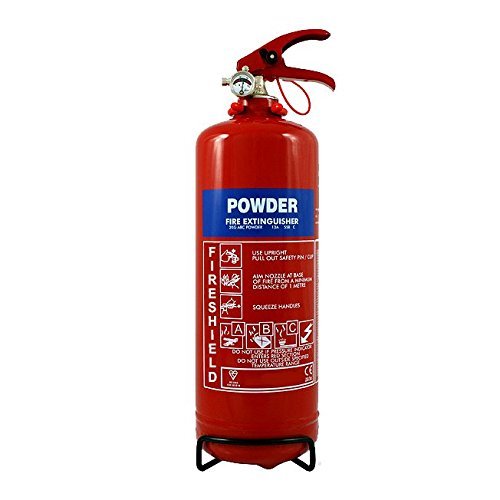
This 2kg powder fire extinguisher can put out class A, B and C fires. These include paper, wood, kerosene, cooking oil and propane fires.
It is also certified for use against electrical fires.
You can leave it sitting on the floor but for maximum safety, mount it on the wall using the included bracket.
It will be more visible, even to visitors, and easier to access.
A pressure gauge indicates the state of the fire extinguisher. Check it once a month to make sure it has not dropped to the red zone.
What we like about it:
- Backed by a 5-year warranty.
- Ideal for most types of house fires including kitchen fires, fire on furnishings and live electrical fires.
- Includes a wall mount.
2. Draper 21675 9L Pressurized Water Fire Extinguisher
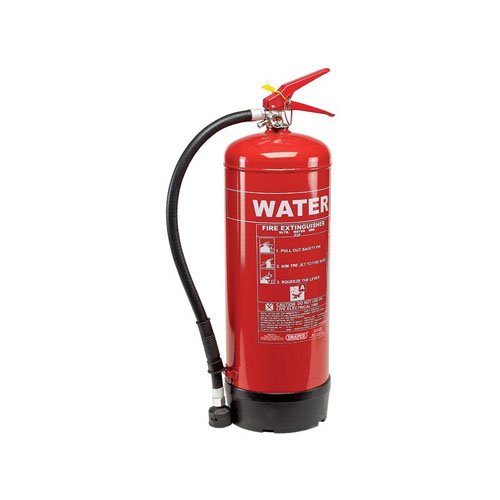
This fire extinguisher is only for Class A fires. These include wood, textile and wood fires.
Do not use it to put out oil or electrical fires.
It contains 9 litres of pressurized water that comes out of a flexible nozzle attached to the head.
It includes a pressure gauge that lets you monitor whether the fire extinguisher is in good condition.
It also comes with a wall-mounting bracket.
What we like about it:
- Ideal for the most common types of house fires (Class A).
- Large capacity – can put out a fairly large fire before it runs out.
- Includes pressure monitor and wall bracket.
3. Kidde KS1KG Multi-Purpose Fire Extinguisher
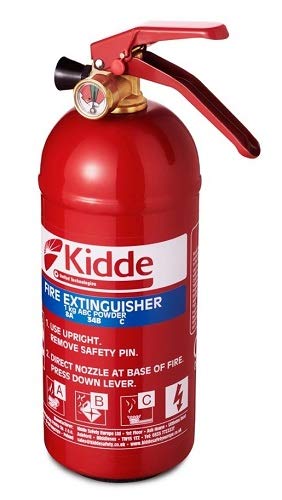
If you are looking for a smaller device for your trailer, car or a small room, we recommend this 1KG extinguisher from Kidde.
It has an ABC rating, meaning it can tackle kitchen fires, wood and paper fires as well as flammable gas fires.
This makes it perfect for kitchens, vehicles and bedrooms.
It has an 8-second discharge time, enough to put out a small fire.
An integrated pressure gauge tells you whether the fire extinguisher is ready to use.
The fire extinguisher comes with a convenient and easy to use mounting bracket.
What we like about it:
- Great for vehicles and small areas.
- Tackles class A, B and C fires.
- Includes a pressure monitor.
4. 950g AA Fire Extinguisher
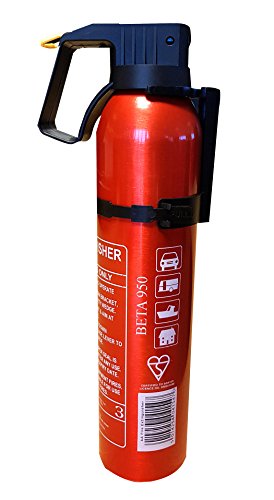
If you need an even smaller fire extinguisher, consider this 950g one from AA.
It has a BC rating, meaning you can only use it on flammable gas and liquid fires. It is also effective against electrical fires.
It’s ideal for vehicles, garages, workshops, caravans and boats.
You can hang it on the wall or inside your car using the included plastic bracket, though customers say the bracket is flimsy and breaks easily.
What we like about it:
- Small enough for caravans, cars and trailers.
- Puts out class B and C fires.
- Backed by a 5-year warranty.
5. FireShield PRO Carbon Dioxide Fire Extinguisher 2KG

This one is only for class B (flammable liquids) and electrical fires.
It uses pressurized carbon dioxide to displace oxygen from the fire, thus snuffing it out.
This CO2 fire extinguisher is ideal for kitchens (appliance fires), the garage, your car or caravan, workshop and game room.
The only issue we have with it is that it lacks a pressure gauge, making it hard to know when you need to get a new one.
What we like about it:
- Good for electrical and flammable liquid fires.
- Includes a mounting bracket.
- 5-year warranty.
Frequently asked questions
What is the advised distance to use a fire extinguisher from?
The ideal distance to use one will be stated on the fire extinguisher as part of the usage instructions.
Most will recommend a distance of 1.8 to 3 meters depending on the range of the extinguisher.
What fire extinguisher should not be used in confined spaces?
Carbon dioxide fire extinguishers. The increased concentration of CO2 and the rapidly depleting oxygen can lead to asphyxiation, unconsciousness and, with prolonged exposure, death.
A powder fire extinguisher also carries some risks when used in a confined space. The powder can block visibility, making it harder to find your way out. To reduce the risk of this happening, identify a safe exit before you spray the powder and keep your back to the exit while extinguishing the fire.
Who is responsible for using a fire extinguisher?
At home, all adults and older kids (6 year and older) in the house should learn how to use a fire extinguisher. Carry out regular fire drills to keep everyone ready in case a fire breaks out.
In a business premise, some or most of the staff should be trained on how to operate available firefighting equipment such as a fire extinguisher or a hose reel.
Do fire extinguishers expire?
No, they don’t. But that doesn’t mean that the extinguisher will be operational forever. Most fire extinguishers have a pressure indicator. When it’s in the red zone, you have to buy a new fire extinguisher or get it serviced.
Most manufacturers recommend having your fire extinguisher serviced every five years. The manufacturer date will be printed on the extinguisher, so you can determine when to get it serviced.
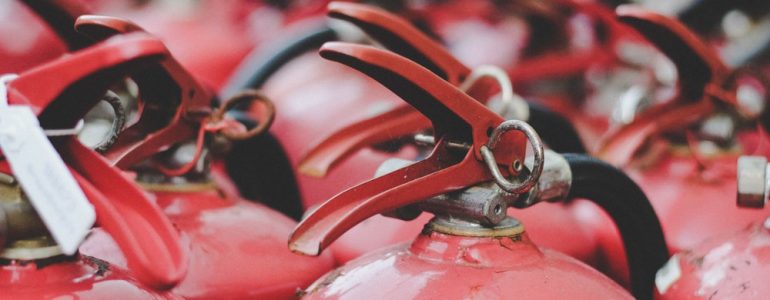
![[A Simple Guide To] The Best Security Chains For Motorcycles [A Simple Guide To] The Best Security Chains For Motorcycles](https://securityclub.co.uk/wp-content/uploads/2018/07/motorcycle-motor-cylinder-technology-52538-70x70.jpeg)





